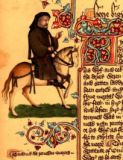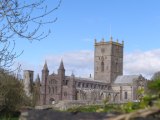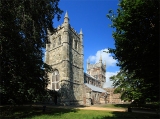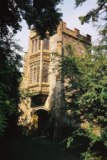 Richard and his family (from The Rous Roll)
Richard and his family (from The Rous Roll)
We have recently looked at a few of the collegiate churches founded by Richard while Duke of Gloucester or later as Richard III and will continue with a few others.
One chronicler who tells us about this is John Rous (1411-1491). Rous spent most of his life under the patronage of the Beauchamps and – after the marriage of Anne Beauchamp to Richard Neville (the “Kingmaker”) – the Nevilles. During Richard’s reign Rous wrote The Rous Roll, a history of the Earls of Warwick, which is full of praise of Richard, the son-in-law of Richard Neville.
Once Henry Tudor was king he changed his tune completely and went on all out attack in his Historia Regum Anglie (History of the Kings of England). This is origin of the legend that Richard’s mother was pregnant with him for two years and when he was born he had teeth and shoulder-length hair. He also accuses him of personally killing Henry VI and poisoning his wife.
Unfortunately for Rous, copies of both texts have survived, which brought him “the distinction of being the most despised of the chroniclers”. However, even among all the accusations of his later work, he sometimes can’t help himself and praises Richard, like in this passage where he talks about Richard’s building programmes:
This King Richard was praiseworthy for his building, as at Westminster, Nottingham, Warwick, York, and Middleham, and many other places, which can be viewed. He founded a noble chantry for a hundred priests in the cathedral of York, and another college at Middleham. He founded another in the church of St. Mary of Barking, by the Tower of London, and endowed the Queens’ College at Cambridge with 500 marks annual rent. The money which was offered him by the peoples of London, Gloucester, and Worcester he declined with thanks, affirming that he would rather have their love than their treasure.
I would not have thought that a Richard who would rather have his subjects’ “love than their treasure” fitted in well with the Tudor world view. This is hardly a sentiment that Henry VII, with whom Rous wanted to ingratiate himself at that time, would have shared.
Bibliography:
Antonia Gransden, Historical writing in England, Volume 2. Routledge, 1982. ISBN 978-0-415-15125-2, pp.309-316
Jeremy Potter, Good King Richard? An Account of Richard III and his Reputation. Constable, London, 1994 (pbk). ISBN 0 09 468840 0, p.88 (incl. quote from History of the Kings of England)
Tags: Church, Contemporaries, Middleham, Richard III








